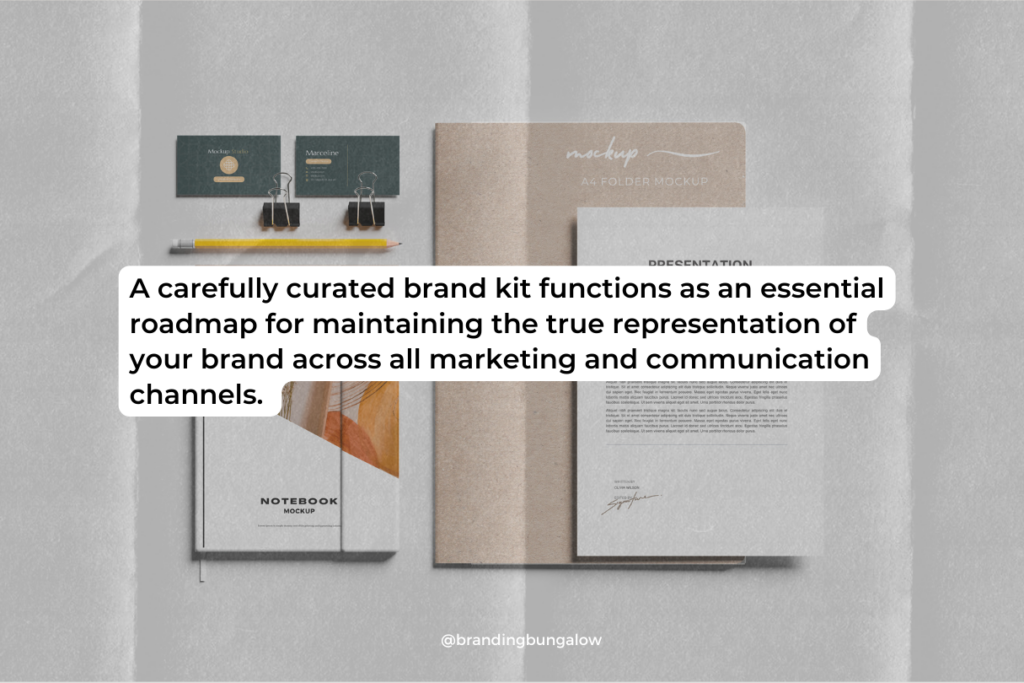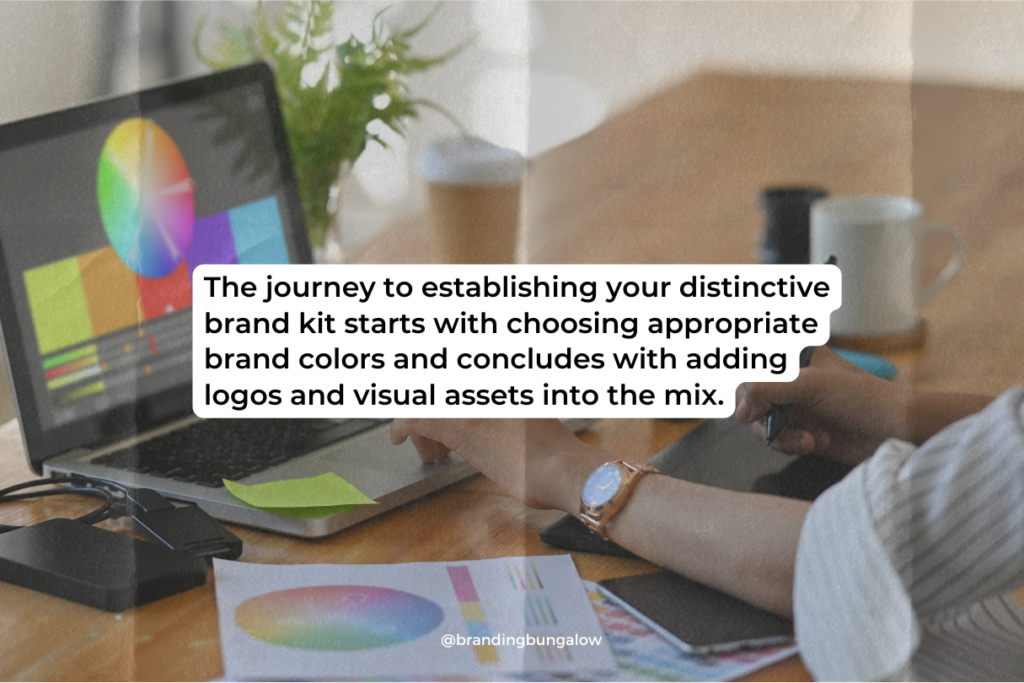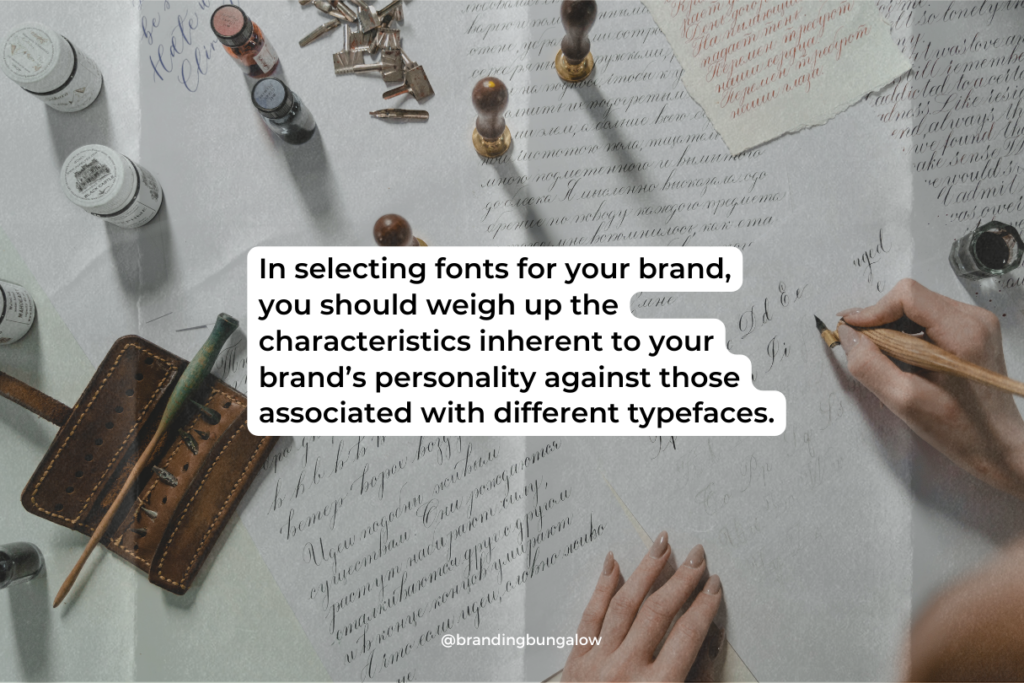Craft the Perfect Branding Kit
Looking to build a powerful brand presence? Learn how a branding kit can be the cornerstone of your business’s image. Uncover the crucial elements included in a branding kit, understand its importance for your company, and explore the detailed steps necessary to create one that ensures consistency and strengthens your brand identity.
Key Takeaways
- A brand kit encapsulates a company’s visual identity, ensuring brand consistency through elements such as logos, color palettes, and fonts, and is vital for both internal and external content creation.
- Brand kits and brand style guides serve distinct purposes; a brand kit provides actual digital assets while a brand style guide offers detailed usage instructions to maintain a uniform brand identity across all applications.
- Regular management and revisions of the brand kit are essential to adapt to changes in market trends, audience preferences, or company direction, and tools like Frontify and Branding Bungalow’s kits can streamline these processes.
Unlocking the Essentials of a Brand Kit

A brand identity kit is not merely an assortment of colors and logos. It captures the essence of your company’s character, crucial for maintaining a uniform brand presence. Typically, it encompasses:
- A comprehensive branding guide
- Main and alternative logos
- Selected color schemes
- Chosen typefaces
- Unique icons
- Standard templates
Consider this collection as a vault that contains all the necessary design elements narrating your unique brand story.
Having a carefully curated brand kit ensures consistency across various branding initiatives. This leads to creating an impressionable, distinct, and easily identifiable brand in the minds of consumers.
Defining the Brand Kit
Imagine the process of designing a promotional flyer that requires your brand’s distinctive colors, exclusive fonts, and various logo adaptations. These vital elements are all neatly assembled within your brand kit—a tool to maintain uniformity in your company’s visual representation. This kit encompasses various iterations of your firm’s emblem including primary, secondary, and iconographic forms along with an array of file formats and dimensions. It presents a meticulously curated color palette featuring main shades as well as complementary and neutral tones.
Having these components at hand simplifies the creative workflow significantly by boosting its productivity.
The Significance of a Brand Kit
A brand kit transcends a mere aggregation of visual elements. It functions as an essential roadmap for maintaining the true representation of your brand across all marketing and communication channels. Consider it akin to a navigational tool, always guiding you towards proper brand alignment. This toolkit is invaluable not only for your in-house marketing team but also for external contractors, ensuring that every piece of content crafted embodies the essence and character of your brand.
This powerful resource does more than capture your brand’s unique voice. It plays a pivotal role in reinforcing both consistency and recognizability within your branding efforts. Should you aspire to amplify the impact of your brand kit while making sure that its colors deeply resonate with and reflect upon your company’s core values, this strategic asset is indispensable.
Crafting Your Own Brand Kit: A Step-by-Step Process

Developing a brand kit for your own business can be an overwhelming endeavor. With proper direction, the experience can become straightforward and beneficial. A brand kit serves as more than just an assortment of design elements. It’s a critical instrument that bolsters your brand identity, setting your business apart in the crowded market landscape.
We shall guide you through each phase needed to establish your distinctive brand kit. This journey starts by choosing appropriate brand colors and concludes with adding logos and visual assets into the mix.
Selecting Your Brand Colors
Selecting the right color palette for your brand is like picking out the perfect attire. It must connect with your target audience and effectively communicate certain feelings or ideas. Representing your company, these five to ten chosen colors that make up your brand’s color palette should be used with regularity and purposeful intent. The primary color is most strongly linked to your brand identity, supported by secondary colors that enhance it.
Neutral shades serve as workhorses in conveying messages across various brand assets. Hence choosing them goes beyond mere visual appeal – it’s crucial for invoking desired emotional responses from audiences.
Typography That Tells Your Brand Story

A typeface has the power to unfold a multitude of narratives, much like an image speaks volumes. It plays a pivotal role in shaping the visual identity of a brand, swaying how your audience views your brand while transmitting its ethos and tone.
In selecting fonts for your brand, you should weigh up the characteristics inherent to your brand’s personality against those associated with different typefaces. The goal is to foster uniformity within your brand identity through the strategic use of a principal typeface for main branding messages, complemented by secondary fonts that cater to varied content structures and scenarios.
Incorporating Logos and Visual Assets

Visual assets and logos serve as the cornerstone of your brand’s visual identity, creating an immediate and memorable impression on your audience. A well-crafted brand kit with these elements promotes uniform branding across multiple platforms.
Whether you craft a bespoke logo through a specialized tool or adapt a pre-designed template, it is essential to forge an emblem that enhances recognition of your brand. After selecting your logos and other visual components, experiment with various pairings alongside your designated brand colors to confirm they communicate your message accurately.
Distinguishing Your Brand Kit from Brand Style Guides
A brand kit and a brand style guide, while they might seem to serve similar purposes, actually fulfill distinct roles in the development of branding. The brand kit includes a set of digital assets ready for immediate use that are essential for representing your brand – these typically encompass logo designs, specific fonts, and designated color codes. In contrast, a brand style guide goes into greater depth by offering comprehensive guidelines on how those elements should be applied visually across various platforms to promote uniformity throughout all forms of media.
Essentially acting as both toolbox and manual: whereas the former provides you with the necessary components straight away for execution (the tools), it is the latter (the instruction manual) that outlines strategies for effectively utilizing such components so as to preserve a coherent identity within your branding efforts. Both instruments are invaluable when forging a strong, consistent image for your brand.
Brand Kit vs. Brand Style Guide
A brand kit serves as an essential toolkit for your branding efforts, equipped with the critical visual components of your brand such as logos, color schemes, and typography. It’s designed to be immediately operational for representing your brand.
Conversely, a brand style guide acts as a comprehensive manual or set of brand guidelines. This extensive documentation delineates the proper usage of items contained within the brand kit. By doing so, it guarantees uniformity in applying these elements on various mediums. Consistency fostered by this adherence strengthens visual identity and amplifies recognition of the brand.
When to Use Each Tool
Understanding the appropriate circumstances for using a brand kit versus consulting a brand style guide is crucial to ensure the consistency of your brand’s representation. A brand kit serves as an indispensable resource for individuals who regularly incorporate various elements of a business’s style into their work, such as:
- Entrepreneurs
- Blog creators
- Design artists
- Independent contractors
By aggregating all essential brand assets in one accessible location, this tool greatly streamlines the design workflow.
Conversely, a comprehensive style guide for your brand becomes particularly valuable when you’re bringing new staff on board or collaborating with outside parties. It provides detailed instructions on presenting the company correctly across assorted channels and types of media. These guidelines support uniformity in branding efforts regardless if someone is crafting visual content for social platforms or composing professional correspondences.
Expanding Your Brand Kit Across Various Mediums

The utilization of a brand kit transcends your business’s website and logo, facilitating its application over numerous platforms to maintain brand consistency. This invaluable tool is your compass when generating an email marketing campaign, developing your site design, or producing video content. It guarantees that wherever your audience encounters your brand, their experience remains consistently aligned with the brand’s identity.
Moving forward, let’s explore how you can extend the reach of your brand kit into areas such as social media and various business materials.
Social Media Consistency
Social media plays a vital role in the digital footprint of your brand. Ensuring uniformity across various channels often poses difficulties. This is where a social media kit comes into play. It’s essentially an extension of your overarching brand kit, specifically designed for social engagements. The social media kit furnishes you with all necessary elements to forge consistent and unified communications on every social platform, encompassing items such as:
- Logos
- Brand colors
- Hashtags
- Images
- Graphics
This specialized toolkit aids in devising and implementing a steady content posting strategy that promotes immediate recognition of your brand among your target audience.
Business Collateral Uniformity
Materials like business cards, flyers, catalogs, brochures, and posters act as vital extensions of your brand. To maintain a consistent brand experience throughout various materials, it’s essential to seamlessly integrate key design elements such as logos and colors that represent your brand.
The importance of these elements extends beyond physical collateral into the digital realm. Emails and other forms of digital communication must also embody your brand’s distinctive identity in order to ensure a coherent and reliable experience with every interaction across all platforms where your business is present.
Managing and Updating Your Brand Kit
A brand kit serves as an ongoing resource that requires consistent attention and updates to reflect your company’s evolving marketing strategy and public persona. Consider it a dynamic entity, advancing in step with the development of your brand. It entails periodic evaluations, gathering insights from various departments within the organization, and conducting brand audits at predetermined times or significant corporate events.
Continuous enhancement of your brand kit aids in bolstering both the effectiveness and assurance of your marketing personnel. This enables them to produce content that is not only more captivating, but also maintains consistency throughout all branding efforts.
When to Revise Your Brand Kit
It’s vital to recognize the appropriate moment for refreshing your brand kit, a task just as important as its original development. You might need to consider an update of your brand kit under certain conditions:
- If your branding seems antiquated compared to what competitors are doing
- When it no longer resonates with current design trends and consumer tastes
- Following any significant shifts within the industry
- In response to changes in who you’re aiming your marketing at
- After noteworthy achievements by the company
These circumstances may prompt you to reassess and possibly revise elements of your brand kit.
As progress and change characterize the journey of your company, ensuring that these developments are mirrored in updates made to the brand kit is crucial. This allows for maintenance of congruence between how you present yourself—your branding—and both where your organization currently stands and where it aims to go in terms of goals and direction.
Tools for Brand Kit Management
Managing the multitude of elements that make up your brand’s visual identity can be challenging. With the advent of management tools for brand kits, this task becomes more manageable. These tools, such as Frontify and Brandfolder, enhance collaborative efforts while ensuring uniformity in branding by providing a centralized location to house, disseminate, and oversee all your brand assets.
Services like Canva, HubSpot, and Adobe Creative Cloud offer capabilities for overseeing your brand kits. This support simplifies content creation processes to ensure they are consistent with your established brand aesthetic—thus preserving the essence of your brand across various platforms.
Branding agencies with expertise and experience in the field, like Branding Bungalow, offer branding kits that simplify the process of crafting and managing your own. Simply download them, input your information, and enjoy your complete brand kit!
Real-World Brand Kit Examples
The adage “seeing is believing” holds considerable weight in the realm of brand kits, exemplified by Yelp’s comprehensive kit. This particular brand kit comprises various segments including ‘Ingredients,’ ‘Recipes & Entrees,’ and a dedicated section emphasizing pivotal design concepts. Yelp offers an exclusive Brand page equipped to deliver detailed guidelines, facilitate easy logo acquisition, and furnish tailored information for prospective collaborators such as partners, resellers, and members of the press or media.
Delving into tangible instances like that offered by Yelp provides us with meaningful understanding on how to proficiently curate our respective brand kits.
Case Study Insights
Examining real-world brand kit examples provides valuable insights, particularly how an effectively maintained brand kit can enhance a brand’s memorability and recognition. Brands that utilize a robust brand kit on platforms such as Yelp align themselves with the way customers search, which in turn boosts their visibility in the marketplace. Whether it’s for photography studios, hotels or plumbing services, these examples demonstrate that brand kits serve as powerful marketing instruments across various industry sectors.
Such observations highlight the importance of possessing a comprehensive and well-managed brand kit for any business looking to cement its presence in the market.
Maximizing Multiple Brand Kits for Diverse Brands
Sometimes, a business may find that one brand kit doesn’t meet all its needs. Especially for businesses responsible for multiple brands or different campaigns, the utilization of several brand kits can elevate their branding strategy. Utilizing distinct brand kits aids in upholding specific campaign rules and ensuring sub-brands stand out, while still preserving the unified message of the overarching brand.
Resources such as HubSpot’s Business Units Add-On are invaluable when it comes to tailoring individual elements for each segment of your business. They assist in maintaining unique visual identities across units without compromising on overall brand consistency.
Creating Separate Brand Identities
Crafting unique identities for subsidiary brands within a larger brand can be complex but fulfilling work. Striking the right balance between standing out and aligning with the overall brand is key. Each sub-brand needs to possess its own character, yet it must harmonize with the overarching identity of the main brand. Employing similar color palettes and typefaces helps in upholding a uniform style throughout all subsidiaries.
Such an approach guarantees that regardless of their distinct target audiences, sub-brands will elicit comparable emotional reactions from consumers, thereby nurturing familiarity and confidence in association with the collective umbrella brand.
Coordinating Multiple Kits
Managing multiple brand kits can seem like a complex balancing act at first, but with the right approach, it becomes an effortless operation. Establishing separate brand kits for each sub-brand provides immediate entry to distinct brand elements, which enhances and simplifies the creative workflow.
Consequently, when you embark on creating campaigns for either your primary brand or any of the sub-brands, every necessary element of the brands will be readily accessible. This ensures efficiency and coherence across all branding efforts.
Summary
In conclusion, a brand kit is an essential tool for any company looking to create a consistent brand identity. From defining your brand kit and understanding its significance, to crafting your own and distinguishing it from a brand style guide, this guide has covered everything you need to know about brand kits. Whether you’re expanding your brand kit across various mediums, managing and updating it, or maximizing multiple brand kits for diverse brands, the importance of a well-crafted and well-maintained brand kit cannot be understated. So, are you ready to put your brand kit together and take your branding to the next level?
Frequently Asked Questions
What is a Canva brand kit?
The brand kit feature in Canva enables the storage of your brand’s unique colors, logos, and fonts to maintain uniformity throughout various designs. This facilitates adherence to your branding guidelines.
To utilize this functionality, log into your Canva account and navigate to the “Brand Kit” section.
Are other brand kits available elsewhere?
Branding agencies like Branding Bungalow typically offer their own branding kits that simplify the process of creating your own. You can often find them on the agency’s website. Simply download them, input your information, and enjoy your complete brand kit!
How do I create a logo kit?
Begin the process of creating a brand logo kit by evaluating your existing brand identity, delving into research about your target market, and examining what your competitors are doing. Next, craft a narrative for your brand story, design the logo itself, and choose both a color palette and typography that align with it.
Doing so will assist in forging a unified and polished presence for your brand.
What is the difference between a brand kit and a brand style guide?
A brand style guide details the appropriate use of assets to uphold a brand’s identity, and these assets are conveniently compiled in a brand kit for practical use.
When should I revise my brand kit?
You should revise your brand kit when it appears outdated compared to competitors, fails to align with current aesthetics and consumer preferences, or when significant changes have occurred in your company or industry. Keeping it up to date ensures it remains effective.
How can I expand my brand kit across various mediums?
Consider diversifying your brand kit by assembling a social media kit that ensures uniform branding across various social networks, and weaving in key brand elements into business materials such as business cards and brochures.
By doing so, you can uphold a unified brand identity throughout varied communication channels.
Recent Blog Entries
Discounts to Dubsado CRM, Helcim Payment Processing and...
Brand audits can save your business' sinking marketing ship.
What's happening to Coke and what you can learn from it.
Shop Products
Create a personalize brand board by taking elements from our 3 signature brand board templates.